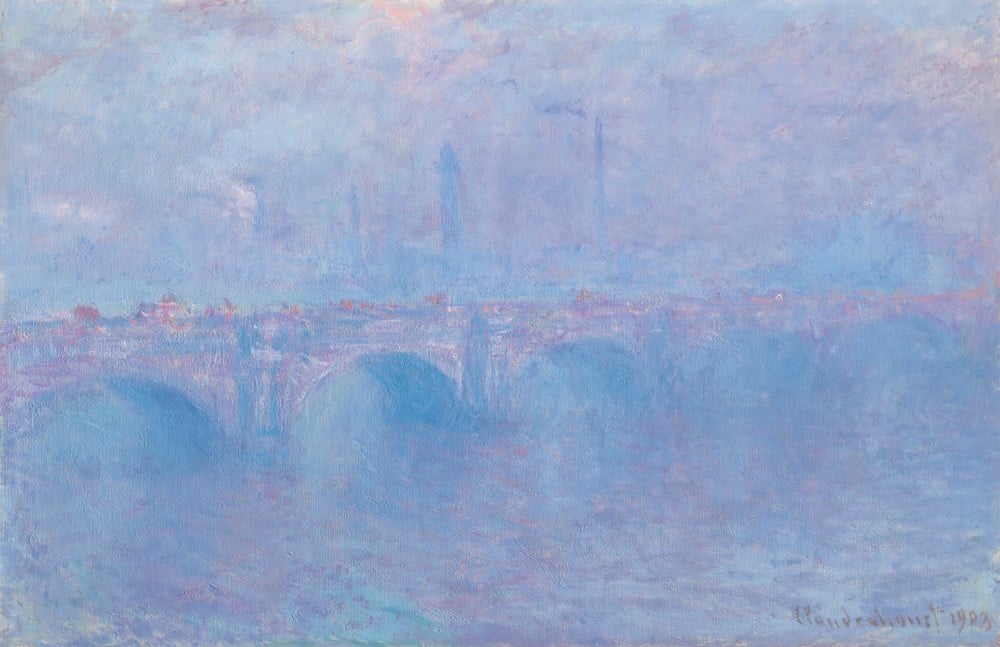
A major turn-of-the century Claude Monet painting will be the highlight of Christie’s upcoming 20th-century art evening sale in New York, which takes place as the auction house makes a shift in how it categorizes historical periods.
But first, the Monet. Waterloo Bridge, effet de brouillard (1899–1903) will be offered on May 11 with an asking price of around $35 million. The work hails from the artist’s series of London paintings, the “Vues du Londres,” which he began in 1899.
With a bird’s-eye view from the balcony at the Savoy Hotel, Monet depicted a panoramic eastward vista that recedes toward a factory-dense south bank beyond. This particular work was one of the earliest of the artist’s London paintings to enter an American collection when it was acquired in 1905 by Pulitzer Prize-winning poet Amy Lowell. It remained with the Lowell family by descent until 1978, and was included in a major Monet retrospective at the Museum of Fine Arts in Boston in 1927.
In May 1999, it sold at Sotheby’s New York for $9.3 million to the same collector who is selling it now.
In the Waterloo Bridge paintings, “you’ve got that incredible structure and this sense of trying to capture the fogs and mists. These are the pictures of light, and changes in the elements,” said Jussi Pylkkänen, global president of Christie’s, in a phone interview with Artnet News.
Pylkkänen said the series marks the artist’s coming of age in the early 1900s, and his move towards what is now regarded as one of the great avant-garde movements of the 20th century.
“This painting is a visual symphony crafted in delicate layers of carefully mixed paints over countless sessions in the studio. He never painted better.”
The previous high for a similar Monet subject was Waterloo Bridge, temps couvert (1904), whch sold at Christie’s London in 2007 to the late billionaire collector Paul Allen for $35.6 million.
“The two are as good as each other, like a brother and sister,” Pylkkänen said of that picture and the current one up for sale. “They have incredible drama and poetry.”
The top price to date for a work by Monet is $110.7 million, paid at Sotheby’s New York in May 2019 for Meules (1890).
Claude Monet, Meules (1890). Courtesy of Sotheby’s.
Meanwhile, Christie’s simultaneously announced plans for a different delineation between modern and contemporary art with new 20th- and 21st-century evening auctions starting this May. The sales will replace the longstanding separate Impressionist and Modern and Postwar and contemporary events.
“It has been in my head for a while,” Alex Rotter, Christie’s chairman of 20th- and 21st- century art, told Artnet News. Art from 80 years ago “is not really contemporary anymore. At some point, we need to move on with our time.”
“There is an understanding from an art-historical point of view that we need to start referencing differently.” Though there will be no hard line, he said works made from 1980 onwards would generally be in 21st-century sales.
“I do see a breaking point with 1980, like Jean-Michel Basquiat in America, Martin Kippenberger, Koons, Christopher Wool. This first generation that came up in the ’80s have really defined the last couple of decades of contemporary art.”
Christie’s 20th-century evening sale in New York will take place on Tuesday, May 11, and present works generally made in the 1880s to the 1980s. The 21st-century sale will be held on Thursday, May 13, and cover everything afterwards.
The latter sale will include Jiréh (2013) a large-scale portrait of the playwright Jiréh Breon Holder by sought-after artist Jordan Casteel, whose work was the subject of a New Museum show last winter. It is estimated to sell for between $350,000 and $550,000.